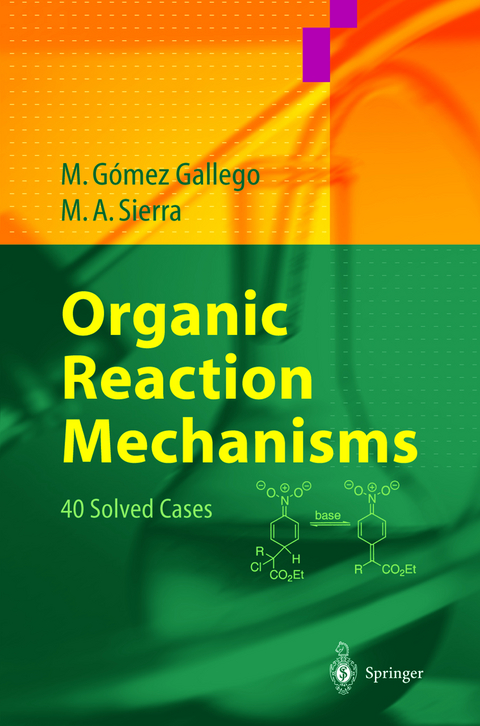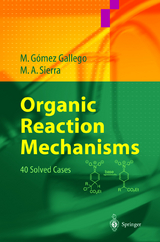Organic Reaction Mechanisms
Springer Berlin (Verlag)
978-3-540-00352-6 (ISBN)
Organic Reaction Mechanisms shows readers how to interpret the experimental data obtained from an organic reaction, and specifically how an organic reaction mechanism can be considered or rejected based on the analysis of the experimental evidence. Examining a series of selected examples of mechanisms, Organic Reaction Mechanisms focuses on real cases and discusses them in detail, following the same methodology: introduction, experimental data and discussion. The examples are arranged to elucidate key aspects of organic reaction mechanisms. The authors employ all the types of information that the authors of the original work considered useful and necessary, including kinetic and thermodynamic data, isotopic labelling and organic reactivity. The book makes an excellent primer for advanced undergraduates in chemistry who are preparing for exams and is also useful for graduate students and instructors.
Miguel A. Sierra studied chemistry at the UCM (Madrid), receiving his PhD in 1987, after which he was appointed Assistant Professor. After a postdoctoral stay at Colorado State University (Professor Louis Hegedus), he returned to Madrid where he was became Professor in 1990. His research encompasses the development of new processes based on transition-metal complexes, the preparation of new bioorganometallic compounds tailor-made for specific applications in crop protection, and the study of environmental organic processes. Professor Sierra is the secretary of the Madrid regional division of the Spanish Chemical Society and a member of the Scientific Advisory Board for the Organization for the Prohibition of Chemical Weapons (OPCW).
Level 1.- Case 1. A Surprise in the Synthesis of Guanacastepene A.- Case 2. Sulfenylation of Indole.- Case 3. Substrate Selective Reactions in the Presence of Lewis Acids.- Case 4. Diastereoselective Reductions of ?-Ketoesters.- Case 5. Rearrangements from Tetrahydropyran Derivatives.- Case 6. Stereospecific Substitution Reactions of Epoxy Sulfides.- Case 7. NaBH4 Reduction of ?,?-Unsaturated Chromium Carbene Complexes.- Case 8. Addition of Hydroxylamines to ?,?-Unsaturated Esters.- Case 9. Solvolysis of Electron-Deficient Norbornyl Triflates.- Case 10 Nucleophile Versus Base Catalysis.- Case 11. The Hydrolysis of p-Substituted Styrene Oxides.- Case 12. Elimination Reactions of Benzaldehyde O-Benzoyloximes.- Case 13. Oxygen Versus Sulfur Stabilization of Carbenium Ions.- Case 14. Cyclization of 2,3-Dibenzylidenesuccinates.- Case 15. Oxazoline N-Oxides as Dipoles in [3+2] Cycloadditions.- Case 16. Light-Induced Cycloadditions of N-Phthaloyl ?Amino Acids.- Level 2.- Case 17. Change in Rate-Determining Step in an E1 cB Mechanism: Aminolysis of Sulfamate Esters.- Case 18. Unusual Diels-Alder Reactivity of Acyclic 2-Azadienes.- Case 19. Chelate-Controlled Carbonyl Addition Reactions.- Case 20. Esterification of Carboxylic Acids with Dimethyl Carbonate and DBU.- Case 21. A Hammett Analysis in a Multistep Reaction: Rhodium(II)-Catalyzed Decomposition of ?Diazo Esters.- Case 22. Tandem Cycloadditions with Nitronates.- Case 23. Hydrolysis of 2-Aminobenzoate Esters.- Case 24. Rearrangements of Cyclobutenones.- Case 25. Epoxi Ester-Orthoester Rearrangement.- Case 26. 2-Chloro-1,3,5-triazines as Activating Groups of Carboxylic Acids in the Formation of Peptide Bonds.- Case 27. Acid-Catalyzed Isomerization of Imines.- Case 28. A Dearomatizing Disrotatory Electrocyclic RingClosure.- Case 29. Stereoselective Debromination of Vicinal Dibromides.- Case 30. Diels-Alder Reactions of N-Acyl-1,2,4,5-tetrazines.- Case 31. Stereoselective Synthesis of 2-Acylaziridines.- Level 2.- Case 32. The Baylis-Hillman Reaction.- Case 33. The Rate-Determining Step in the SNAr Reaction.- Case 34. Helicenophanes and their Racemization.- Case 35. Solvolysis of Vinyl Iodonium Salts.- Case 36. Vicarious Nucleophilic Substitution.- Case 37. Base-promoted HF Elimination from 4-Fluoro-4-(4'-nitrophenyl)butan-2-one.- Case 38. Substitution of ?Halostyrenes Mes.- Case 39. Periodinane-Mediated Cyclization of Anilides.- Case 40. Solvolysis of 8-Deltacyclyl Brosylates.
From the reviews:
"The authors of this book utilise recently published research work to illustrate and instruct the reader on how to interpret experimental data to account for product stereochemical outcomes and propose reasonable reaction mechanisms. Matching mechanisms to justify experimental results with no or limited supportive experimental evidence is tricky as often more questions are raised than answered, but in the majority of the 40 papers presented, Gallego and Sierra are reasonably convincing with their discussion of plausible mechanisms..... This book is suitable for the hyper-enthusiastic advanced organic chemistry undergraduates who are destined to higher research degree studies and for graduates and professional organic chemists who like linking experimental data to organic structures."
Chemistry in Australia, 10/2004, p. 30
"The book makes an excellent primer for advanced undergraduates in chemistry who are preparing for exams and is also useful for graduates students and instructors."
Journal: Chimie Nouvelle - Societe Royale de Chimie, Vol. 22, Issue 87, p. 122
"Organic Reaction Mechanisms shows readers how to interpret the experimental data obtained from an organic reaction ... . Examining a series of selected examples of mechanisms, Organic Reaction Mechanisms focuses on real cases and discusses them in detail ... . The book makes an excellent primer for advanced undergraduates in chemistry who are preparing for exams and is also useful for graduate students and instructors." (Chimie Nouvelle Societe Royale de Chemie, Vol. 22(87), 2004)
"Learning by doing is the approach pursued by Gallego and Sierra in their book ... . The chemical concepts and reaction types introduced to the reader cover practically all of the addition, substitution, and elimination reactions known in traditional organic chemistry. ... Ample space is also given to ... . The book is a valuable resource for the preparation of seminarson organic reaction mechanisms, and as such it should be available in a good university library." (Hendrik Zipse, Angewandte Chemie, Vol. 116(37), 2004)
"Organic Reaction Mechanisms: 40 Solved Cases presents cases of organic reaction mechanisms using formal representation ... . The examples are treated in detail with an introduction, experimental data, discussion, key points and additional references. The approach of the authors is original since they do not approach the reaction ... . This volume will be useful to advanced undergraduate students and researchers interested in understanding the mechanism of organic reactions." (John F. Kennedy, Francois Meullenet, Carbohydrate Polymers, Vol. 57, 2004)
"Working with three-dimensional molecules, changes to solvent or catalyst and other such factors may dramatically alter the course of a reaction, and these subtleties are not readily appreciated by most students. ... The authors of this book try to redress this deficiency by bringing together a series of organic reactions whose mechanistic details have been probed using a variety of techniques and approaches. ... will also offer lecturers a useful set of worked problems with which to illustrate their courses." (Andrew Boa, Times Higher Education Supplement, February, 2005)
"Organic Reaction Mechanics shows the readers how to interpret the experimental data obtained from an organic reaction ... . This book in which the strategy of synthesis has been discussed will be useful for undergraduates, Ph. D. students and scientists ... . Lecturers can find in the text new examples to illustrate topics of advanced chemistry. After reading this book specific interest can be found by a physicist who deals with investigations of chemical or biochemical processes by physical methods." (Yu. Galyametdinov, Applied Magnetic Resonance, Vol. 28 (1-2), 2005)
"What resources do you need to teach mechanistic organic chemistry? More often than not, quickaccess to appropriate, contemporary examples ... . For that reason alone I can commend Gomez Gallego and Sierra's book ... . The book is well organized. ... The scope of the examples is a real asset. ... The references are also valuable. ... I can see it becoming a very useful resource for educators at advanced undergraduate and postgraduate level." (Jim Iley, Chemistry World, Vol. 2 (7), 2005)
"The mechanism of a chemical reaction can be considered as a hypothetical motion picture of the behavior of the participating atoms. The reliability of the proposed mechanism increases if it leads to quantitative predictions as to how the speed of the reaction is affected by concentrations of reactants, temperature, solvent and the presence of catalysts. The interpretation of the experimental data is a key point in any type of experimentation. The book on Organic Reaction Mechanisms explains the various approaches to interpret the experimental data obtained from an organic reaction and specifically how an organic reaction mechanism can be considered or rejected based on the analysis of experimental evidence. ...All the cases presented in the book have been nicely illustrated that cover all the main topics of organic chemistry and this book is an innovative contribution to the subject. In conclusion, this book can be excellent source of information not only to the students but also to the academicians working in the area of organic chemistry." (John F. Kennedy, Univ. Birmingham; Journal: Carbohydrate Polymers, Issue 65, 2006)
| Erscheint lt. Verlag | 17.11.2003 |
|---|---|
| Zusatzinfo | X, 290 p. 9 illus. in color. |
| Verlagsort | Berlin |
| Sprache | englisch |
| Maße | 155 x 235 mm |
| Gewicht | 650 g |
| Themenwelt | Naturwissenschaften ► Chemie ► Anorganische Chemie |
| Naturwissenschaften ► Chemie ► Organische Chemie | |
| Naturwissenschaften ► Chemie ► Physikalische Chemie | |
| Schlagworte | Anorganische Chemie • Cycloaddition • Inorganic Chemistry • Nucleophilic substitution • Organic Chemistry • Organic Reaction Mechanisms • Organische Chemie • Organische Reaktionsmechanismen • Organische Stoffe/Verbindungen • Physical Chemistry • Physikalische Chemie • Reaktionen (chem., physikal.) • rearrangement |
| ISBN-10 | 3-540-00352-5 / 3540003525 |
| ISBN-13 | 978-3-540-00352-6 / 9783540003526 |
| Zustand | Neuware |
| Haben Sie eine Frage zum Produkt? |
aus dem Bereich




